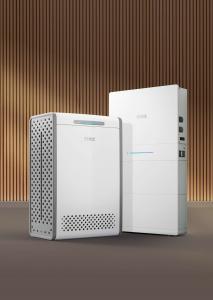SENEC focuses on global future technology with new LFP storage generation
New generation of SENEC home storage systems based on lithium iron phosphate (LFP) batteries to be presented at ees Europe 2024
LEIPZIG, SAXONY, GERMANY, June 19, 2024 /EINPresswire.com/ -- At the COP28 world climate conference last year, countries agreed to triple the capacity of renewable energies by 2030, with solar energy and wind power taking centre stage. The special report ‘Batteries and Secure Energy Transitions’ published by the International Energy Agency (IEA) in April now points out that this target will only be achieved through a massive expansion of storage capacities and at the same time sets out key trends in the battery market: In 2023, the market share of lithium iron phosphate (LFP) batteries has risen to 40 per cent of electric vehicle sales and 80 per cent of new battery storage systems. A trend that Leipzig-based storage specialist SENEC is also following with its new product generation, which will be presented at ees Europe 2024 from 19 June.In order to realistically achieve the targets, a six-fold increase to a total of 1,200 gigawatts of storage capacity is required. The IEA expects that around 90 per cent of this will be covered by battery storage, while the remainder will mainly be distributed among pumped storage plants. This would mean annual battery storage growth of 25 per cent, which would include both large-scale battery storage systems and consumer solutions, for example due to the trend towards e-cars and the combination of home storage systems with photovoltaic systems.
Low-cost batteries: Key to moving away from fossil fuels
While, according to the IEA, a growing fleet of electric vehicles in the transport sector is
expected to replace the need for 8 million barrels of oil per day by 2030 in the ‘net zero emissions by 2050’ (NZE) scenario, battery storage will gradually support a shift away from coal and natural gas use. At the same time, the efficiency of electricity systems is constantly increasing by reducing losses and bottlenecks in the electricity grids.
The predominant role of battery storage systems is primarily due to the rapid technical progress and simultaneous fall in prices as more and more production capacity is created. Batteries have become 90 per cent cheaper in the last 15 years - and according to the IEA, costs will fall by a further 75 per cent by 2030.
This success is largely due to the battery chemistry trend of lithium iron phosphate (LFP), which is the key growth driver in the field of stationary battery storage. A key advantage of LFP cathodes lies in material processing, as they contain only a few critical minerals compared to previous solutions based on nickel, manganese and cobalt.
To date, China has dominated production capacities for battery technologies. However, more than 40 per cent of future capacities will be built in Europe and the USA. This would mean an improvement in the regional availability of batteries and a reduction in supply chain bottlenecks.
SENEC follows global battery storage trends
With its 360° energy ecosystem, Leipzig-based storage specialist SENEC has been contributing to the energy transition for more than 15 years. In Germany alone, more than 1.2 million home storage systems have been installed which, in combination with photovoltaic systems, maximise the owner's own consumption. With its latest generation of storage systems, SENEC is now following the clear trend towards modern LFP battery technologies. These include the SENEC.Home E4 and SENEC.Home P4 models. Both storage systems - including other solutions for the energy transition in the home - will be presented at ees Europe from 19 June.
About IEA Special Report
The IEA's Special Report on Batteries and a Safe Energy Transition highlights the important role of battery technologies in fulfilling recent commitments adopted by nearly 200 countries at COP28, including tripling global renewable energy capacity by 2030, doubling the pace of energy efficiency improvements by 2030 and transitioning away from fossil fuels.
The report summarises the latest data and information on batteries from around the world, including the latest market developments and technological advances. The special report also looks at battery storage in the power sector and electric mobility. By looking at the entire battery ecosystem, from critical minerals and manufacturing to utilisation and recycling, it identifies synergies and potential bottlenecks in different sectors.
https://www.iea.org/events/batteries-and-secure-energy-transitions
About SENEC
SENEC GmbH in Leipzig has been developing intelligent electricity storage systems and storage-based energy solutions since 2009. With SENEC.360, the company offers a coordinated ecosystem for sustainable all-round self-sufficiency, including electricity storage (SENEC.Home), solar modules (SENEC.Solar), a virtual electricity account (SENEC.Cloud) and an e-car charging station (SENEC.Wallbox). The SENEC brand has developed into one of Europe’s leading providers of innovative energy and storage solutions for single-family homes - with over 150,000 systems sold and an advisory network of more than 1,200 specialist partners.
Since 2018, SENEC GmbH has been a wholly-owned subsidiary of EnBW Energie Baden-Württemberg AG and employs more than 650 people at its Leipzig and Cologne sites as well as in Italy.
www.senec.com
Ingola Metz
SENEC GmbH
presse@senec.com
Visit us on social media:
LinkedIn
Legal Disclaimer:
EIN Presswire provides this news content "as is" without warranty of any kind. We do not accept any responsibility or liability for the accuracy, content, images, videos, licenses, completeness, legality, or reliability of the information contained in this article. If you have any complaints or copyright issues related to this article, kindly contact the author above.

